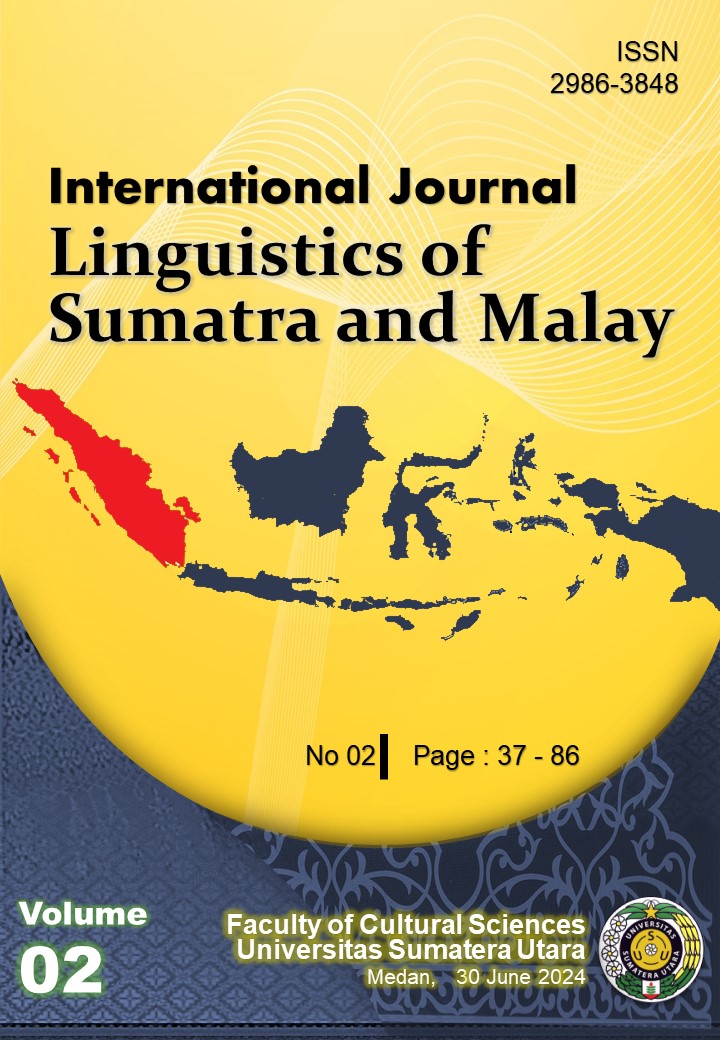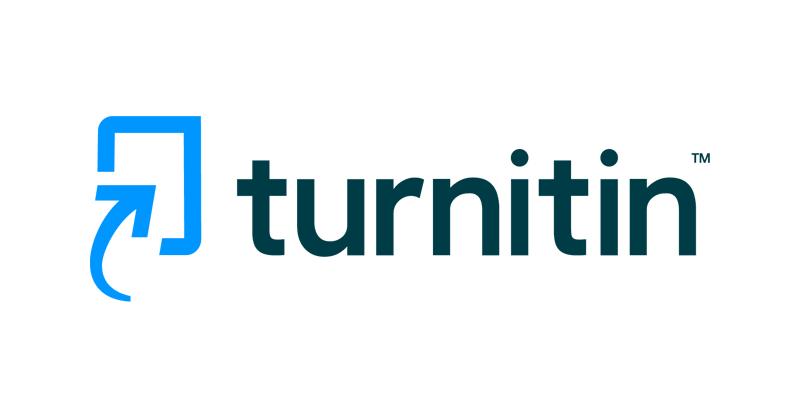Flora Lexicons in Acehnese Proverb: Ecolinguistic Study
DOI:
https://doi.org/10.32734/ijlsm.v2i2.14529Keywords:
Flora Lexicon, Acehnese Proverb, EcolinguisticAbstract
This study aimed is to examine flora lexicons in Acehnese Proverbs. This study used a qualitative approach with descriptive and a content analysis method. This data was analysed using the Miles and Huberman method; the data source for this research was Hasyim's book (1977) of Acehnese proverbs. The result showed that The flora lexicon found in Acehnese proverbs in the form of nouns includes Bak mee (tamarind), Trieng (bamboo), Reuböng (bamboo shoots), Beuringén (banyan), Kacang (peanut), U (coconut), Teubèe (sugarcane), Pineung (areca), Labu (pumpkin), Mangga (mango), Panah (jackfruit). Acehnese proverbs that use flora/botanical analogies are used to express satire, advice, and wisdom.
Downloads
References
Abi, G. N., Kardana, I. N., & Sujaya, N. (2022). Eco-lexicon of Flora and Fauna in Baikeno Language. KnE Social Sciences, 105-118.
Chaer, Abdul. (2007). Lexicology and Indonesian Lexicography. Jakarta: Rineka Cipta.dalam Perspektif Ekolinguistik. USU.
Egbuta, Chinyere O. (2011). The Pragmatics of the Nkporo Proverb: The Nkporo Example. Disertation : University of Nigeria, Nsukka.
Fill, Alwin dan Muhlhausler, Peter. (2001). The Ecolinguistics Reader: Language, Ecology, and Environment. London: Continuum.
Gupta, A. K., Tulsyan, S., Thakur, N., Sharma, V., Sinha, D. N., & Mehrotra, R. (2020). Chemistry, metabolism, and pharmacology of carcinogenic alkaloids present in areca nut and factors affecting their concentration. Regulatory Toxicology and Pharmacology, 110, 104548.
Hestiyana, H. (2021). Bentuk Keragaman Leksikon Flora dalam Pengobatan Tradisional Masyarakat Dayak Halong: Kajian Ekolinguistik (Forms of Flora Lexicon Diversity in Traditional Medicine of the Dayak Halong Community: Ecolinguistic Study). Sirok Bastra, 9(2), 185-198.
Ino, L., Nirmalasari, N., Darlian, L., Damhuri, D., Suraya, R. S., & Alkausar, M. (2022). Flora Lexicon of Kaghati in Muna Speech Community. JURNAL ARBITRER, 9(1), 39-47.
Jufika, M. (2019). Kajian Ekolinguistik Leksikon Flora Dan Fauna Peribahasa Indonesia Dalam Novel Atheis (Doctoral dissertation, UNIVERSITAS ANDALAS).
Mahayana, I. M. A., Sukiani, N. K., Suwendri, N. M., & Winaya, M. D. (2019). Leksikon-leksikon flora dalam metafora bahasa Bali: Kajian Ekolinguistik. Kulturistik: Jurnal Bahasa dan Budaya, 3(2), 41-50.
Maldonado-Celis, M. E., Yahia, E. M., Bedoya, R., Landázuri, P., Loango, N., Aguillón, J., ... & Guerrero Ospina, J. C. (2019). Chemical composition of mango (Mangifera indica L.) fruit: Nutritional and phytochemical compounds. Frontiers in plant science, 10, 1073.
Mbete, A. M. (2009). Refleksi Ringan tentang Problematika Keetnika dan Kebahasaan
Mbete. (2014). Mamfaat Kajian Ekolinguistik dalam Upaya Pelestarian Bahasa, Budaya dan Lingkungan (Benefits of Ecolinguistic Studies in Efforts to Preserve Language, Culture and the Environment). The Proceedings of the National Seminar on Ecolinguistics of the Cultural Park of North Sumatra
Mubshirah, D & Mulyadi (2023). The Synonym of Meaning in Acehnese And Indonesian Proverbs: Cognitive Semantic Analysis. RETORIKA: Jurnal Ilmu Bahasa, 9(1), 100-113.
Ndruru, M. (2020). Leksikon Flora pada bolanafo bagi guyub tutur Nias kajian ekolinguistik. Jurnal Education and Development, 8(2), 257-257.
Needham, A., Jha, R., & Lincoln, N. K. (2020). The response of breadfruit nutrition to local climate and soil: A review. Journal of Food Composition and Analysis, 88, 103451.
Pateda, M. (2010). Semantik Leksikal. Jakarta: Rineka Cipta
Prastio, B., Nurzafira, I., & Susanto, G. (2021). Lexicon in Batik and Tapis Cloth of Lampung, Indonesia: Ecolinguistics Study. KnE Social Sciences, 72-88.
Pujiono, M., & Gapur, A. (2019). Ekolirik Dalam Lagu Anak Jepang: Tinjauan Dua Douyou. IZUMI, 8(1), 9. https://doi.org/10.14710/izumi.8.1.9-19
Pulungan, Anni Holida. (2013). Kajian Etnolinguistik Terhadap Peribahasa Dalam Bahasa Indonesia: Sebuah Tinjauan Pragmatik Force (Daya Pragmatik). Journal etnolinguistik terhadap peribahasa.
Ranasinghe, R. A. S. N., Maduwanthi, S. D. T., & Marapana, R. A. U. J. (2019). Nutritional and health benefits of jackfruit (Artocarpus heterophyllus Lam.): a review. International journal of food science, 2019.
Rao, Y. S., & Mathew, K. M. (2012). Tamarind. In Handbook of herbs and spices (pp. 512-533). Woodhead Publishing.
Rathna, T. S., Eliazer Nelson, A. R. L., Ravichandran, K., & Antony, U. (2019). Nutritional and functional properties of coloured rice varieties of South India: a review. Journal of Ethnic Foods, 6(1), 1-11.
Razei, A. (2012). Rhetorical function of proverbs based on literary genre. Elsevier: Procedia - Social and Behavioral Sciences 47 ( 2012 ) 1103 – 1108.
Sampe, J., Maknun, T., & Iswary, E. (2022). Dimensi Praksis Sosial Leksikon Flora dalam Kada Tominaa pada Acara Ma’bua’Suku Toraja Analisis Ekolinguistik. Gema Wiralodra, 13(2), 858-882.
Saputra, N., Suwandi, S., & Setiawan, B. (2022, December). The Embodiment Of Ecocritic Contained In The Hadih Maja Aceh. In Proceeding International Conference on Innovation in Science, Education, Health and Technology (Vol. 1, No. 1, pp. 350-359).
Sharma, P., Kaur, G., Kehinde, B. A., Chhikara, N., Panghal, A., & Kaur, H. (2020). Pharmacological and biomedical uses of extracts of pumpkin and its relatives and applications in the food industry: a review. International Journal of Vegetable Science, 26(1), 79-95.
Sibarani, Robert. (1997). Lexicography. Medan: USU Press.
Silalahi, M. (2019). Lexical Items in Batak Toba Language Representing Fauna, Flora and Social Environment: Ecolinguistic Study. Flora and Social Environment: Ecolinguistic Study (August 23, 2019).
Sundana, L., & Jumiati, R. (2021). Ekologi Alam dalam Hadih Maja Aceh. Pedagogika: Jurnal Ilmu-Ilmu Kependidikan, 1(2), 5-10.
Tarigan, B., Setia, E., Widayati, D., & Mbete, A. M. (2016). Language Maintenance and Shift of Flora’s Lexicons in Karonese Traditional Food: An Ecolinguistic Perspective. Communication and Linguistics Studies, 2(1), 13-17.
Yadnya, I. B. P., Simpen, I. W., & Satyawati, M. S. (2021). The Flora and Fauna Lexicons within the Ama Samawa of Sumbawa Society in Indonesia: Ecolinguistic Perspective. The International Journal of Language and Cultural (TIJOLAC), 3(01), 29-35.
Yuniawan, T., Rokhman, F., & Zulaeha, I. (2020). Eco-Linguistic Analysis on Flora and Fauna Lexicons on the Motifs of Batik Pekalongan, Indonesia. International Journal of Advanced Science and Technology, 29(5), 6549-6566.
Zulaikhah, S. T. (2019). Health benefits of tender coconut water (TCW). Int J Pharm Sci Res, 10(2), 474-80.
Downloads
Published
Issue
Section
License
Copyright (c) 2024 International Journal Linguistics of Sumatra and Malay

This work is licensed under a Creative Commons Attribution-ShareAlike 4.0 International License.
All articles published in the International Journal Linguistics of Sumatra and Malay (IJLSM) are licensed under the Creative Commons Attribution-ShareAlike 4.0 International License (CC BY-SA 4.0).
This license permits anyone to:
-
Share — copy and redistribute the material in any medium or format.
-
Adapt — remix, transform, and build upon the material for any purpose, even commercially.









